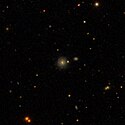IC 3624
| Galaxie IC 3624 | |
|---|---|
 | |
| SDSS-Aufnahme | |
| AladinLite | |
| Sternbild | Jungfrau |
| Position Äquinoktium: J2000.0, Epoche: J2000.0 | |
| Rektaszension | 12h 39m 34,5s [1] |
| Deklination | +11° 58′ 56″ [1] |
| Erscheinungsbild | |
| Morphologischer Typ | E[1] |
| Helligkeit (visuell) | 15,2 mag[2] |
| Helligkeit (B-Band) | 16,2 mag[2] |
| Winkelausdehnung | 0.30 × 0.3[2] |
| Flächenhelligkeit | 12.7 mag/arcmin²[2] |
| Physikalische Daten | |
| Rotverschiebung | 0.073914 ± 0.000151[1] |
| Radialgeschwindigkeit | 22.159 ± 45 km/s[1] |
| Hubbledistanz H0 = 73 km/(s • Mpc) | (988 ± 69) 𐄁 106 Lj (302,9 ± 21,2) Mpc [1] |
| Geschichte | |
| Entdeckung | Royal Harwood Frost |
| Entdeckungsdatum | 10. Mai 1904 |
| Katalogbezeichnungen | |
| IC 3624 • PGC 1401857 • 2MASX J12393449+1158561 • | |
IC 3624 ist eine elliptische Galaxie vom Hubble-Typ E im Sternbild Jungfrau am Nordsternhimmel. Sie ist schätzungsweise 988 Millionen Lichtjahre von der Milchstraße entfernt und hat einen Durchmesser von etwa 90.000 Lichtjahren.
Im selben Himmelsareal befinden sich u. a. die Galaxien NGC 4579, NGC 4606, IC 3604, IC 3643.
Das Objekt wurde am 10. Mai 1904 von Royal Harwood Frost entdeckt.[3]
Weblinks
Einzelnachweise
Auf dieser Seite verwendete Medien
Autor/Urheber: Sloan Digital Sky Survey, Lizenz: CC BY 4.0

Angle of view: 4' × 4' (0.3" per pixel), north is up.
Details on the image processing pipeline: https://www.sdss.org/dr14/imaging/jpg-images-on-skyserver/